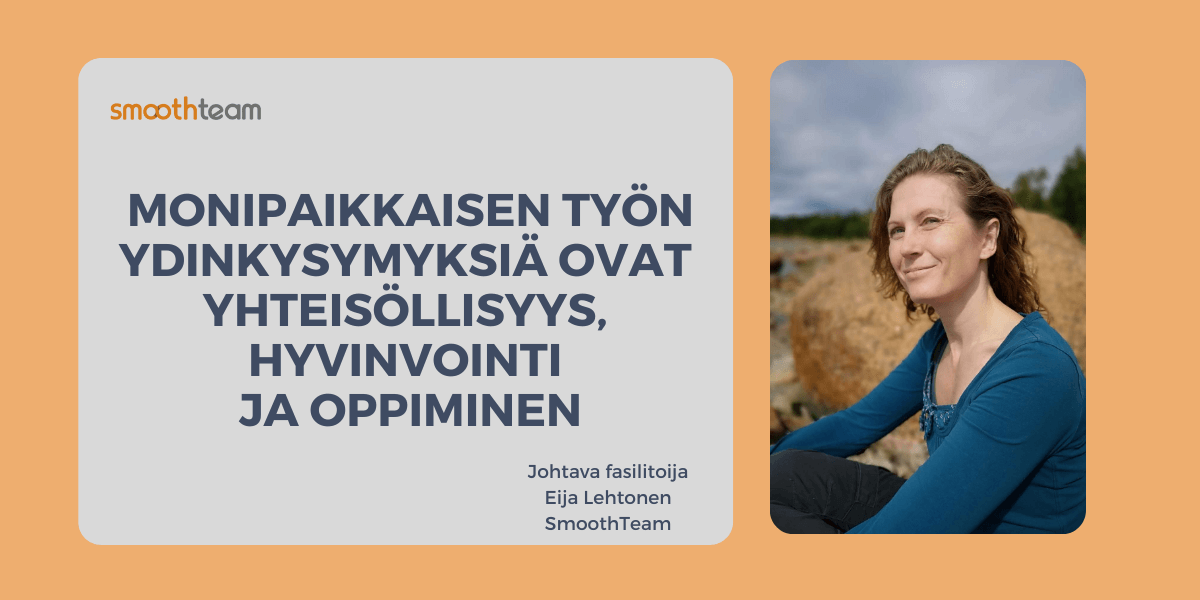Why do we need to talk about organising and managing work in multiple locations? Because people are no longer sitting in an office at work as they used to. A small number still want to go to the office every day, a small number want to work only remotely. The majority fall somewhere in between, working in the office, at home, in their leisure homes, in cafés or even when travelling. The old practices no longer work as such. Here are three important perspectives on multisite working.
Now that time has passed since the beginning of the pandemic, you can see the path that views and experiences of teleworking and multi-site working have taken. The starting point was that telecommuting was seen as the norm, teleworking and multi-site working were the exception. Then the pandemic hit and most people working in information and professional jobs were forced to telework for months without warning. After the initial crisis came the honeymoon period, when it was discovered that nothing stood still and almost everything could be done remotely: lunches, coffees, parties, training courses, not to mention the day-to-day meetings. I read an expert's view from 2020 in which he described how the difficulties of working remotely are mainly due to a lack of familiarity and competence. We have now reached a stage where teleworking and multi-site working are realistically seen as both a challenge and an opportunity. Neither is good or bad in itself, both are needed and both have their place.
Three important aspects of multi-location work
If I had to sum up the issues of multi-site working and management in three core themes, they would be community, well-being and learning.
Community is one of the three basic human needs, in addition to autonomy and competence. How workplace builds a sense of belonging in a multi-site workplace is an important part of the group Community is born from small everyday actions and practices, and is still strongly associated with face-to-face encounters, sharing feelings and ideas, and even laughing together.
Working from multiple locations challenges the well-being of both frontline workers and employees. As much as there are good things about teleworking, studies show that it is also a burden. It is difficult to disengage from work, it is intense, concentrated toil from one meeting to the next, and loneliness and lack of support often take their toll in the long run. You don't always have the energy or the ability to look after yourself. It is more difficult for front-line staff or colleagues to detect excessive strain and exhaustion when face-to-face encounters are reduced. As we know well, it is not always easy to detect one's own condition in time and slow down.
The third threshold issue I raise is learning. Studies show that up to 80% of learning in the workplace comes from outside training. Workplace learning is largely informal, on-the-job, and often social. Where we do not meet as before, important questions include how do we document knowledge and skills, transfer tacit knowledge or develop creative new solutions to problems in a multi-professional way?
Reconciling autonomy and working together
Sometimes there is a conflict between the individual's right to choose where he or she works and the shared responsibility for work, professional development and performance. Being able to choose where you work gives you more autonomy, but where do rules agreed with the team about when to be there come into play?
SmoothTeam simulations help to set the rules of the game
We have reached the point where "something has to be done". In the absence of a ready-made model that fits every community, communities have to create the rules themselves. It can seem difficult to get a team around the table and start a conversation - about what?
In fact, we've run two simulations of multi-site working at SmoothTeam: a traditional model simulation called Hybrid Work in Control, where we first do a self-assessment and then in different situations we name others according to what strengths we see in them. At the beginning of February, we also released a new multi-selection simulation, Multisite Work, which goes straight to what gives each person energy and well-being at work, regardless of where they work, without self-assessments. Discussions during the simulation allow people's different perspectives to be heard to support work development. Book a demonstration and we'll show you more about how simulations work.


